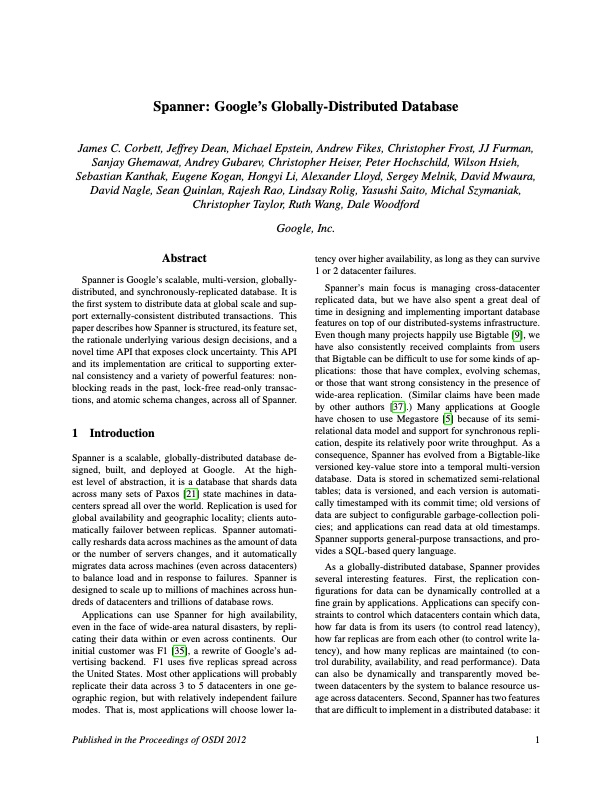
PDF Publication Title:
Text from PDF Page: 001
Spanner: Google’s Globally-Distributed Database James C. Corbett, Jeffrey Dean, Michael Epstein, Andrew Fikes, Christopher Frost, JJ Furman, Sanjay Ghemawat, Andrey Gubarev, Christopher Heiser, Peter Hochschild, Wilson Hsieh, Sebastian Kanthak, Eugene Kogan, Hongyi Li, Alexander Lloyd, Sergey Melnik, David Mwaura, David Nagle, Sean Quinlan, Rajesh Rao, Lindsay Rolig, Yasushi Saito, Michal Szymaniak, Christopher Taylor, Ruth Wang, Dale Woodford Abstract Spanner is Google’s scalable, multi-version, globally- distributed, and synchronously-replicated database. It is the first system to distribute data at global scale and sup- port externally-consistent distributed transactions. This paper describes how Spanner is structured, its feature set, the rationale underlying various design decisions, and a novel time API that exposes clock uncertainty. This API and its implementation are critical to supporting exter- nal consistency and a variety of powerful features: non- blocking reads in the past, lock-free read-only transac- tions, and atomic schema changes, across all of Spanner. 1 Introduction Spanner is a scalable, globally-distributed database de- signed, built, and deployed at Google. At the high- est level of abstraction, it is a database that shards data across many sets of Paxos [21] state machines in data- centers spread all over the world. Replication is used for global availability and geographic locality; clients auto- matically failover between replicas. Spanner automati- cally reshards data across machines as the amount of data or the number of servers changes, and it automatically migrates data across machines (even across datacenters) to balance load and in response to failures. Spanner is designed to scale up to millions of machines across hun- dreds of datacenters and trillions of database rows. Applications can use Spanner for high availability, even in the face of wide-area natural disasters, by repli- cating their data within or even across continents. Our initial customer was F1 [35], a rewrite of Google’s ad- vertising backend. F1 uses five replicas spread across the United States. Most other applications will probably replicate their data across 3 to 5 datacenters in one ge- ographic region, but with relatively independent failure modes. That is, most applications will choose lower la- tency over higher availability, as long as they can survive 1 or 2 datacenter failures. Spanner’s main focus is managing cross-datacenter replicated data, but we have also spent a great deal of time in designing and implementing important database features on top of our distributed-systems infrastructure. Even though many projects happily use Bigtable [9], we have also consistently received complaints from users that Bigtable can be difficult to use for some kinds of ap- plications: those that have complex, evolving schemas, or those that want strong consistency in the presence of wide-area replication. (Similar claims have been made by other authors [37].) Many applications at Google have chosen to use Megastore [5] because of its semi- relational data model and support for synchronous repli- cation, despite its relatively poor write throughput. As a consequence, Spanner has evolved from a Bigtable-like versioned key-value store into a temporal multi-version database. Data is stored in schematized semi-relational tables; data is versioned, and each version is automati- cally timestamped with its commit time; old versions of data are subject to configurable garbage-collection poli- cies; and applications can read data at old timestamps. Spanner supports general-purpose transactions, and pro- vides a SQL-based query language. As a globally-distributed database, Spanner provides several interesting features. First, the replication con- figurations for data can be dynamically controlled at a fine grain by applications. Applications can specify con- straints to control which datacenters contain which data, how far data is from its users (to control read latency), how far replicas are from each other (to control write la- tency), and how many replicas are maintained (to con- trol durability, availability, and read performance). Data can also be dynamically and transparently moved be- tween datacenters by the system to balance resource us- age across datacenters. Second, Spanner has two features that are difficult to implement in a distributed database: it Published in the Proceedings of OSDI 2012 1 Google, Inc.PDF Image | Google Globally-Distributed Database

PDF Search Title:
Google Globally-Distributed DatabaseOriginal File Name Searched:
spanner-osdi2012.pdfDIY PDF Search: Google It | Yahoo | Bing
Cruise Ship Reviews | Luxury Resort | Jet | Yacht | and Travel Tech More Info
Cruising Review Topics and Articles More Info
Software based on Filemaker for the travel industry More Info
The Burgenstock Resort: Reviews on CruisingReview website... More Info
Resort Reviews: World Class resorts... More Info
The Riffelalp Resort: Reviews on CruisingReview website... More Info
| CONTACT TEL: 608-238-6001 Email: greg@cruisingreview.com | RSS | AMP |